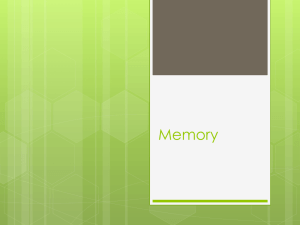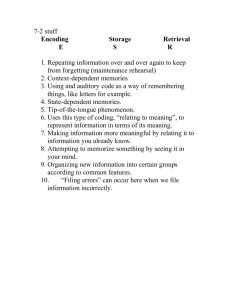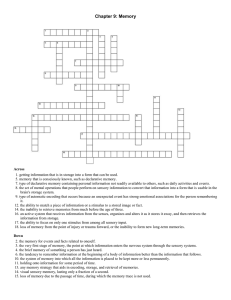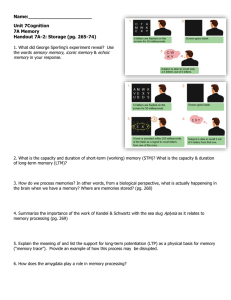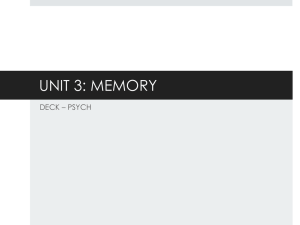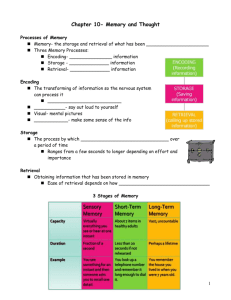Memory - heather-auten
advertisement
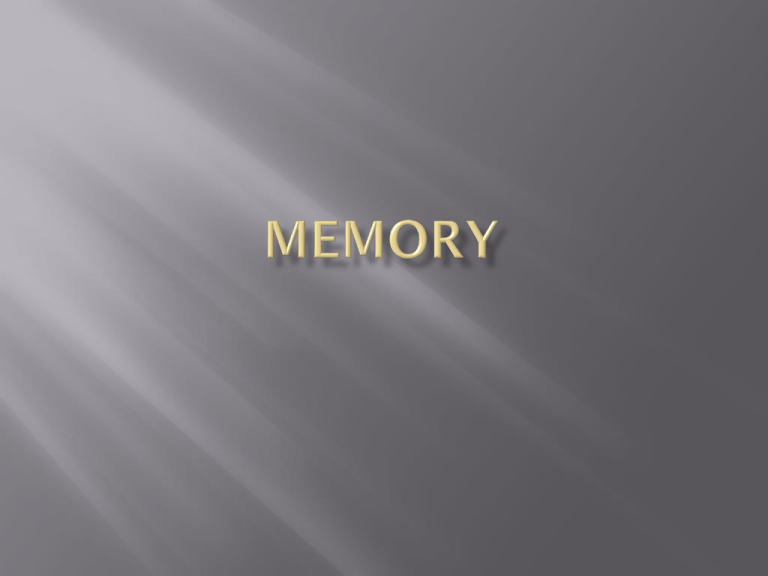
Memory is the process by which we recollect prior experiences and information and skills learned in the past. We classify memory according to the different kinds of information it contains: events, general knowledge, and skills. Episodic Memory is memory of a specific event. Flashbulb Memories are memories of events that are so important that you remember it in every detail. On your own sheet of paper write a paragraph about one of the following: A vivid childhood memory or your earliest childhood memory. Be as detailed as possible. Semantic Memory is the general knowledge that we acquire. These types of memories are things like knowing George Washington was the first president. 20 Questions game. Explicit memories are memories of specific information. Semantic and Episodic Memories are explicit (clear). Implicit memory consists of the skills or procedures you have learned. Such as throwing a ball, riding a bicycle, skipping rope, or swimming. Let’s demonstrate skills. Explicit memory is used on recall task, that is being able to recall information learned. Whereas Implicit memory is under the surface all the time. As you explore the environment around you, you are constantly taking in information. This may explain why an elderly person is able to function well in the home they have lived in for years but seem disabled when put in an unfamiliar environment. In what ways do we organize memories? For your personal memories, what kind of memories do you recall best? Encoding is processing information into a form in which it can be stored. This is how you make sense of information. On a sheet of paper, write this list of letters OTTFFSSENT Look at the letters for 30 seconds and memorize as much of the list as you can. Visual codes Acoustic Codes Trying to form a mental picture in your mind. Reading a list over and over and then repeating it back to yourself. (Either out loud or silent) Acoustic codes record the letters in your memory as a sequence of sounds. Semantic Codes Trying to memorize by trying to make sense of a group. Storage is the maintenance of encoded information over a period of time. Storage is used to put information into short term or long term memory. Maintenance Rehearsal is repeating information over and over again to keep from forgetting. This is how we attempt to remember names and phone numbers before we get the opportunity to write them down. Trying to memorize a phone number. Use chunking to memorize and store the number. Elaborative Rehearsal is when new information is made meaningful by relating it to information you already know well. Example: This is used in education, such as when a foreign language teacher or English teacher encourage students to use new vocabulary in sentences. Organizational Systems are how your memories that are stored become organized and arranged in your mind for future use. Example: When learning presidents, you know that Washington comes before Jefferson, and Jefferson before Lincoln. You have stored this in your mind in chronological order. This activity deals with the process of storage known as chunking. Get a partner. Tell your partner that you are going to read some numbers and you want him or her to remember as many as possible. Don't tell your partner how many numbers or what range they will be in. Read these numbers in the following order at a rate of about 1 every second. Immediately ask your partner to write down the numbers he or she remembers. Now tell your partner that you will read another set of numbers and you want him or her to remember them. Read these numbers in the following order at a rate of about 1 every second. Immediately ask your partner to write down the numbers he or she remembers. Was the second time easier? Did your partner remember more numbers the second time? Both sets of numbers are exactly the same...it is just that the second one can really be "chunked" into 1...one series of numbers that is easy to remember. Retrieval is locating stored information and returning it to conscious thought. Recall is retrieval of learned information Some memory is more familiar, and is therefore easier to retrieve. These are things like names of friends and family, etc. But, attempting to remember a math formula may be more difficult. Think back to the letters we wrote down a few minutes ago. Try to write them down again without looking at them a second time. If you had encoded them you would be able to retrieve them easier than had you just repeated them over and over. You have 30 seconds. Try to remember as many of the 20 pictures as possible. Now write down everything you can remember that was pictured. The pictures were: butterfly, pencil, ice cream cone, rainbow, house, chair, clock, telephone, kite, lock, scissors, guitar, light bulb, airplane, apple, computer, earth or globe, plant, hammer, cake. Context-Dependent memory is retrieving a memory based on the situation in which a person first had the experience being remembered. An experiment involving context-dependent memory involved some students who belonged to a swimming club. They were asked to memorize lists of words while they were in the water of the pool, while others tried to memorize out of the pool. When asked to recall, or retrieve, the information the students remembered more words in whichever setting they learned them in. State-Dependent Memory is when you can retrieve a memory because of the mood in which they were originally created. For example, feelings of happiness will bring back memories from other times when we were happy. Tip-of-the-tongue phenomenon is when we are so close to retrieving information that it seems as though the information is on the “tip of the tongue.” Also sometimes called “feeling of knowing experience.” An example of this is when you try to remember someone's name. Such as someone’s last name be Swanson, but you think it is Samsonite. On page 163 in the textbook there is a chart that you need to have in your notes. Draw that in the space provided on your notesheet. Describe the 3 processes of memory. Which type of encoding works best for you personally to remember something? We do not store in our memory everything we experience. What we do remember and encode depends on what happens to the information as it flows through each of the three stages of memory. The stages are: Sensory Memory Short-Term Memory Long-Term Memory Sensory Memory is the first stage of memory. It consists of the immediate, initial recording of information that enters through our senses. http://faculty.washington.edu/chudler/java/ sencon.html Iconic Memory is the sensory register that holds the mental pictures we form of visual stimuli. These are very brief because it involves the senses. Eidetic Imagery is the ability to remember visual stimuli over long periods of time. Most of us think of this as photographic memory. Echoic Memory is a sensory register that holds mental traces of sounds. Because of echoic memory, acoustic codes are easier to remember. Saying things to yourself makes it easier to remember. Short-Term Memory is also called working memory, you can transfer anything from the sensory register to short-term if you pay attention. We use our short-term memory a lot. Any time you are thinking about something it is in your short-term memory. http://faculty.washington.edu/chudler/stm0. html http://faculty.washington.edu/chudler/java/ facemem.html Primacy effect is the tendency to recall the initial items in a series of items. Recency effect is the tendency to recall the last items in a series. Think back to the list of numbers we memorized. 3 12 5 8 13 1 6 4 14 11 10 2 7 9 15 The primacy effect suggests that you will remember 3, 12, 5, and 8 better than the rest of the list. The recency effect suggests that you will remember 2, 7, 9, and 15 better than the rest of the list. Chunking is the organization of items into familiar or manageable units. Return to the list of letters: OTTFFSSENT If you tried to list them as 10 individual pieces they were meaningless, but if you remembered them in pieces or as some other variation such as “Other Flowers Sent” then you chunked them together. This process of short term memory is also why phone numbers are 7 digits broken into 2 separate parts, or why social security numbers are 3, 2, and 4 numbers. It, however, becomes very difficult to remember any list over 9 items long. Interference occurs when new information appears in short-term memory and takes the place of what is already there. An experiment by Lloyd and Margaret Peterson (1959) showed how new information can cause problems. Remember the three letter combination: ZBT What are the three letters I asked you to remember? Now remember the letters: NQB Count backward from 150. Now what were the 3 letters I asked you to remember. Memory and awareness drill. Who is missing? Long-Term Memory is how we store memory that we want to keep longer than the short term. To do this there are several steps we go must go through. We must go through mechanical repetition (maintenance rehearsal) Storage Retrieval There are more words, pictures, sounds, smells, tastes, and touches than you could count stored in your long term memory. Capacity of Memory: Psychologists have yet to discover a limit to how much can be stored in a person’s long-term memory. There are a vast number of videos and films of out lifetime of experience stored in our longterm memory. However, our memory is limited by how much attention we pay to things. Memory as Reconstructive: Our memories are reconstructed from the bits and pieces of our experience. We tend to shape information based on the way we view the world. What do you see these two shapes to be? Schemas are the mental representations that we form of the world by organizing bits of information into knowledge.

